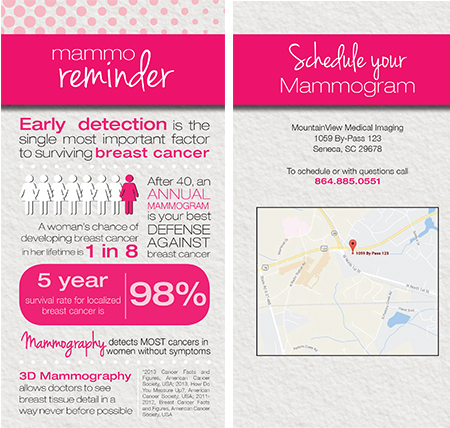Mammography examines the breast using x-rays. Mammography is considered the most effective tool for early breast tumor detection. Mammography plays a central part in early detection of breast cancers because it can show changes in the breast before a patient or physician can feel them. Most medical experts agree that successful treatment of breast cancer depends on early diagnosis.
What are the advantages of digital mammography and computer-aided detection?
-
Compared to conventional mammography which takes 10-15 minutes, digital mammography images are taken in about 5 minutes.
-
The superior contrast resolution of digital mammography and its ability to manipulate images make for more accurate detection of breast cancers.
-
Computer-aided detection, or CAD, obtains a second, computerized reading in the hope of finding more cancers.
-
Digital mammograms can be archived and easily retrieved and copied.
How often should I have a mammogram?
Current guidelines from the American Cancer Society (ACS), and the American College of Radiology (ACR) recommend screening mammography every year for women, beginning at age 40.
The National Cancer Institute (NCI) recommends that women who have had breast cancer and those who are at increased risk due to a genetic history of breast cancer should seek expert medical advice about whether they should begin screening before age 40 and possibly have a breast MRI.
When should I schedule my mammogram?
Before scheduling a mammogram, you should discuss problems in your breasts with your doctor. Generally, the best time is one week following your period. Do not schedule your mammogram for the week before your period if your breasts are usually tender during this time. Always inform your x-ray technologist if there is any possibility that you are pregnant.
How should I prepare for a mammogram?
On the day of the exam:
-
Do not wear lotion, deodorant, or powder under your arms or on your breasts
-
Describe any breast problems you are experiencing with the technologist
-
Remove all jewelry and clothing from the waist up. You will be given a gown that opens in the front.
What should I expect during this exam?
To image your breast, an x-ray technician will position you near the machine and your breast will be placed on a platform and compressed with a paddle. Breast compression is necessary in order to:
-
Spreads out the tissue so that small abnormalities won’t be obscured.
-
Reduces radiation dose and improves picture sharpness.
-
Hold the breast still to eliminate blurring of the image caused by motion.


